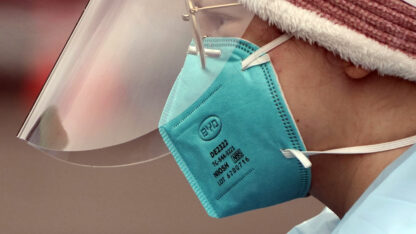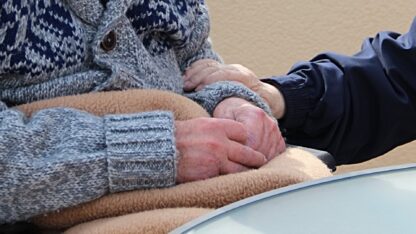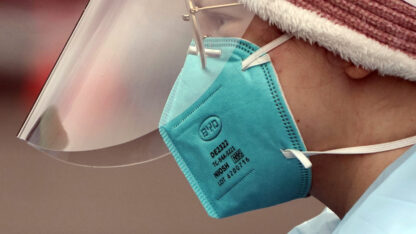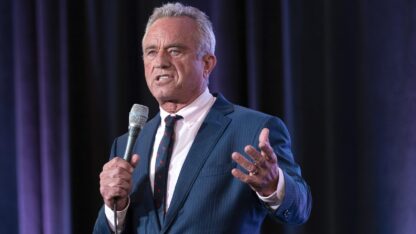Across the country, about two-thirds of large school districts currently require students to wear masks. Most commonly, those masks are cloth. And cloth masks, experts say, are insufficient to contain the spread of Omicron.
Where one goes with those two pieces of information is, increasingly, a pandemic Rorschach test.
For some the answer is obvious: upgraded masks, stricter rules. On Jan. 21, the Los Angeles Unified School District, the nation’s second-largest school district, updated its mask policy to exclude cloth masks. California has distributed tens of millions of N95 masks and kid-sized KN95 masks to schools. And in districts as disparate as Boston, Denver, and Round Rock, Texas, student activists have been demanding respirators in the name of safety.
For others, resisting school masking along with other pandemic restrictions remains a largely political stance. For example, the newly elected Republican governor of Virginia wasted no time in ending the state’s school mask mandate by executive order, setting off a flurry of opposition.
What’s different about this moment is that there is a third camp – call them pro-vaccine, anti-mask. And they’re getting louder.
Total cases and pediatric hospitalizations are still high. The Centers for Disease Control and Prevention and the American Academy of Pediatrics continue to recommend universal masking in schools as they have since the start of the pandemic.
Yet as the Omicron wave begins to peak in some parts of the U.S., some pediatricians, neuroscientists, special education teachers and parents like Dingle are talking more about the potential negative impacts of prolonged masking.
Even mask proponents – who point to the many studies associating mask mandates with lower COVID rates in schools – acknowledge the difficulties of masking children.
Others are questioning the fairness of continuing to require masks for children indefinitely, especially when they are less often required in many of the places adults gather, like restaurants and bars.
Good masks are hard to find
Jeremy Howard, a data scientist, is the lead author of a widely cited review of evidence supporting masking against the coronavirus. He thinks schools should absolutely continue to mandate masks, citing the still-emerging science of long COVID.
His issue is that good masks are rare.
“It’s very hard to even find pediatric KN95s or pediatric KF94s. And there’s no such thing as pediatric N95s.”
That’s because standards for N95 masks were created for occupational and workplace safety. According to the Food and Drug Administration, “N95 respirators are not designed for children … a proper fit cannot be achieved on children.”
Howard’s read of the evidence is that cloth and even surgical masks are much less useful against Omicron. Yet while there are some recommended, high-quality, child-size respirators on the market, many, he adds, are of lower quality than the adult versions. “They work much less well most of the time,” he says. “So, yeah, it’s a huge issue. Kids are being left unprotected.”
Danny Benjamin is a pediatrician with Duke University and the ABC Science Collaborative, which has long advised school districts that masking can be highly effective against COVID spread. “If you’re in a school district that masks, the risk of COVID is much less at school than it is outside of school, because school is one of the few places where people actually enforce mitigation measures.”
But in his view, while respirators offer superior protection, mandating them for children is impractical: some kids find them uncomfortable, they may not fit small faces well and they need to be replaced often. For the nation’s 55 million school children, Benjamin says, “now we’re talking about 100 million masks that you’re mandating each week. And that’s kind of the best-case scenario where: you reuse most of them, no child ever loses their mask and no child ever soils their mask, which, I don’t know what planet that is.”
It’s hard for children to wear masks properly
Teachers and parents often report that proper mask-wearing is difficult and requires constant reinforcement by teachers. That’s especially true for young children and those with special needs.
Bernadette Ngoh, who runs an in-home daycare in West Haven, Conn., spends time almost every day sitting down with children and telling them why masks are important. She calls it, “The biggest challenge … What do we do with all the kids that are unable to wear the mask and stay with the mask?”
Brittany Gonzalez teaches special education to second- and third-graders in Lee County, Florida. Her students aren’t required to wear masks. Those who do “take it off all day,” she said. “It is a foreign piece of cloth on their face. And not all of them have the level of understanding as to why we’re doing it and what it means and how to wear it.”
Masks can interfere with young children’s brain development
Numerous scientific papers have established that it can be harder to hear and understand speech and identify facial expressions and emotions when people are wearing masks. (Some of these studies also suggest workarounds, which many practitioners are using).
These are critical developmental tasks, particularly for children in the first three years of life.
The United States is an outlier in recommending masks from the age of 2 years old. The World Health Organization does not recommend masks for children under age 5, while the European equivalent of the CDC doesn’t recommend them for children under age 12.
Manfred Spitzer is a psychiatrist and a cognitive neuroscientist in Germany.
He published a scientific review of evidence on how masking could impact children’s development.
Spitzer says the negatives of masking are particularly clear for very young children. He believes that young children’s caregivers should be unmasked as well.
“Kids need to train up their face recognition,” he says, and they need to see full faces to learn to identify emotions as well as to learn language. “Babies were never designed just to see the upper half of the face and to infer the lower half; even adults have a hard time doing this.”
Masks can make it harder to hear and understand speech
Kerry Dingle, the mother in Silver Spring, says her nearly 4-year-old son has a speech delay that had been resolving, with treatment, before the pandemic, but has now gotten worse again. “He doesn’t make back-of-the-throat sounds. So cookie is tuttie.“
Diane Paul is with the American Speech-Language-Hearing Association, the national professional association representing speech therapists. She says referrals of children to speech therapy have increased since the pandemic began.
But, Paul adds, there are no studies to prove – or disprove – that this is due to masking rather than, as she believes, the lingering effects of remote learning and other factors of the pandemic.
Donna Smiley is an audiologist – a hearing-impairment specialist – also with ASHA.
“We all use visual input to help understand the message,” she says – watching a speaker’s lips and mouth, which are covered by masks. “By putting on a mask, you’re also making the teacher’s voice less loud.”
CDC guidance allows for the use of masks with clear plastic when interacting with people with hearing impairments, young children, those who are deaf or hard of hearing, those receiving speech therapy, students learning to read or those learning a new language.
Smiley says she’s found those pose problems. “The material that it is made out of … fogged up pretty easily.” And, she says–and at least one study has found–the plastic blocks even more sound than cloth does.
Like Spitzer, Smiley and Paul believe masking should continue as long as necessary for public health, but teachers should be aware of the limitations. They say masking’s challenges are real, but manageable with adjustments that improve communication for everyone.
Masks can inhibit social interactions
For school-aged children, Spitzer, the psychiatrist, is most concerned that masking interferes with nonverbal communication and emotional bonding.
Gonzalez says her students who are on the autism spectrum withdraw behind masks. “They have almost started adopting the masks as their face. It’s part of their identity, it’s their security blanket. I almost have to be like, ‘Hey, you are allowed to take it off right now.’ Like, say, if they’re going to run the lap at P.E. or going into lunch to sit down – they want to eat a bite, put it back on, eat a bite, put it back on.”
Mothers of typically-developing children, like Stephanie Avanessian in Los Angeles, are worried about their kids, too. “They can never see their friends smile,” she says. “They can never see their friends frown! They’re not developing empathy. It’s taken six months for my fifth-grader to make friends because it’s so hard to tell what people are doing.”
For Spitzer, these potential problems with masking can be overcome for older children. For example, by saying “That’s funny!” to make up for the hiding of a smile. “This can all be compensated to some extent.”
But for younger children, he doesn’t support masks. Germany doesn’t require masks for children under age 6.
“When speech no longer happens, when communication is interfered with, I think if that happens for a week, that’s OK,” he explains. “But if that happens for half a year, that’s eternity when it comes to brain development, at a very young age.” He points out that COVID is usually mild for young children, but it’s a critical period for development.
Balancing children’s needs and pandemic safety
A post-masking consensus may be closer than it appears.
In November, before the Omicron variant had emerged in much of the U.S., Randi Weingarten, the president of the American Federation of Teachers, wrote a letter to U.S. Education Secretary Miguel Cardona and the CDC director, Rochelle Walensky, asking for a masking off-ramp. She said classroom teachers were reporting “that the constant use of masks impedes the learning process,” and that parents “have expressed dismay about their child’s overall well-being after wearing a mask continually for well over a year and a half.”
AFT spokesperson Andrew Crook told NPR that the national teachers union still supports a path away from school mask mandates. “You can’t do it right now because of Omicron, but yes, with a metric and guidance you can have an off-ramp.”
Danny Benjamin at the ABC Science Collaborative also believes that mask mandates can be safely relaxed, post-surge – assuming high vaccination rates – meaning 100% for adults and at least 70% for students. “Any family that wants to protect their child should simply vaccinate their child, and at that point the risk of COVID is substantially less than the risk of flu,” he says.
On Jan. 25, a group of physicians and scientists announced a national campaign to “restore normalcy” in children’s lives by putting them first in line for the lifting of restrictions, including mask mandates, once the Omicron wave has subsided.
Dr. Jeanne Noble, who directs COVID response for the UCSF Emergency Department at the University of California, San Francisco, is part of the coalition. “Kids don’t need to be masked. Full stop. They have minuscule risk of serious illness or death from COVID,” she says. She and colleagues are suggesting that especially vulnerable children continue to mask while other vaccinated children can safely go without.
Copyright 2022 NPR. To see more, visit https://www.npr.org.
9(MDAxODM0MDY4MDEyMTY4NDA3MzI3YjkzMw004))

9(MDAxODM0MDY4MDEyMTY4NDA3MzI3YjkzMw004))









